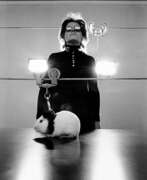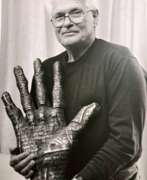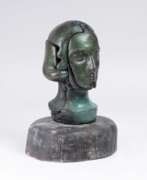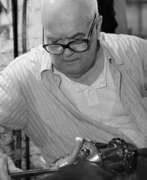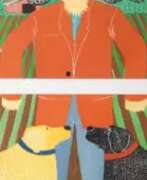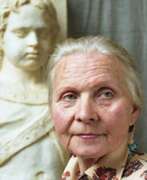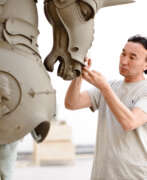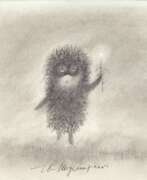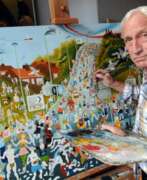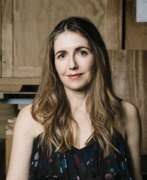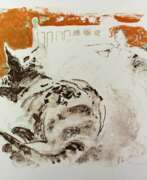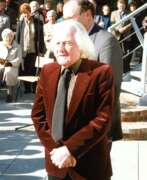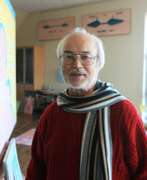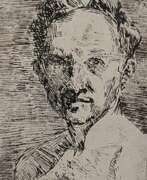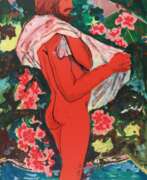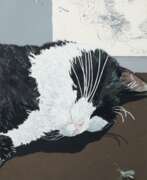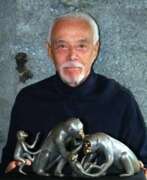Animalists 21st century
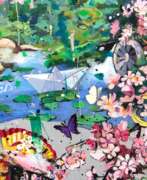

Angelo Accardi is a contemporary Italian artist. He grew up surrounded by both modern and traditional art. Although he studied fine art at the Art Academy of Naples, he never completed his training. Angelo Accardi illustrates surreal visions of everyday life under realistic backdrops of urban and natural landscapes. There is never a single meaning, but a whole story behind each painting. Ironic, striking, and playful, Accardi’s unique perspective and avant-garde style is a result of his diverse inspirations.
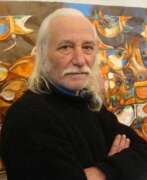

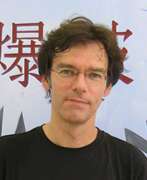

Andreas Amrhein is a contemporary german artist. His first verified exhibition was Arbeiten auf Papier „Blau“ at Galerie Michael Schultz in Berlin in 1994. Andreas Amrhein is most frequently exhibited in Germany, but also had exhibitions in Austria, China and elsewhere.
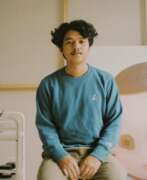

Roby Dwi Antono is a visual artist mainly creating surrealistic paintings as well as sculptures and prints. His work opens a portal to another universe where spaceships, aliens, dinosaurs and creatures with humanly features come together. These surrealistic creations that once lived only in Dwi Antono’s imagination come to life in a new realm on his canvas. Inspired by his childhood memories and love for Fiction movies, his paintings are left for the viewer to interpret.
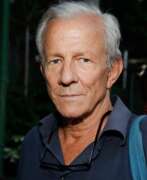

Peter Hill Beard was an American artist, photographer, diarist, and writer who lived and worked in New York City, Montauk and Kenya. His photographs of Africa, African animals and the journals that often integrated his photographs, have been widely shown and published since the 1960s.
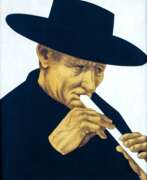

Arne Besser is a contemporary American artist. He received training as an artist at the Art Center School, Los Angeles. There he studied with John Audubon Tyler and Lorser Feidelsson. Beser’s approach to Photo-Realism is to draw from the urban landscape and nature a succinct “set like” image of reality. His city scenes depict New York street life alive with trading and traders, prostitutes and junkies looking for a fix. These visual images iconify the underside of urban life in a way that elevates this point of view to an almost mythic level.
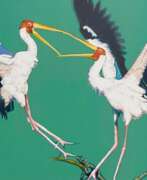

Fran Bull is an American sculptor, painter, and print-maker living and working in Brandon, Vermont and Barcelona, Spain. Bull became known originally for her Photorealism paintings made in the mid 1970s and 80s. In the late 1980s, Bull’s art began to develop towards abstraction, or neo-abstract expressionism. Sparked by her newfound approach to painting, in the mid-1990s Bull began to explore other media. Since that time her artistic output has included performance art, sculpture, mixed media, and printmaking, as well as painting. She has been especially prolific in the area of printmaking. Bull has produced many diverse series of etchings that continue to be exhibited worldwide.
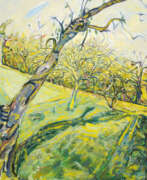

Bernard Chaet was an American artist. Chaet is known for his colorful, dynamic modernist paintings and masterful draftsmanship, his association with the Boston Expressionists, and his 40-year career as a Professor of Painting at Yale University. His works also include watercolors and prints. In 1994, he was named a National Academician by the National Academy of Design. Chaet's works are in the permanent collections of many important museums. Chaet is known for his association as a first generation Boston Expressionist. Having studied with Zerbe, a father of Boston Expressionism, Chaet's early works certainly adhere to the techniques and philosophy of the school.
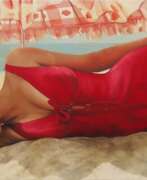

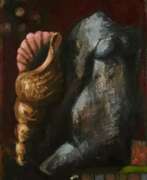

Peter Chevalier is a German painter whose paintings and drawings are close to surrealism. In the 1980s, Chevalier juxtaposed the realistic with the abstract in his paintings. Clearly configured individual but combined things (houses, airplanes, stumps of columns, light bulbs, bones, etc.) dominated, which – as if one were cutting out illustrations from magazines and reassembling them as a collage – are inconsistent in their proportions in the pictorial context.
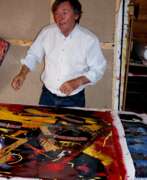

Christian Clerebout is a French contemporary artist. He spent his childhood in Africa, which has left an indelible imprint in his painting style. He studied art from 1966 until 1979 in Paris and Rome. Before settling indefinitely in Brittany, he ran away to North America, lured by the United States, and New York, in particular. This is where his powerful cityscapes evolved: engorged with sweeping movement, brilliant colors and intense darks and lights. He has expanded creatively to include such subject matters as orchestras, airports, elephants and financial themes, but his expressive style is always recognizable.
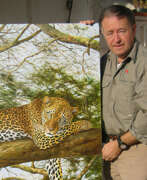

Pierre Cousy is a contemporary French animal painter. For twenty years he worked in a team of researchers in the history of the Languedoc-Roussillon region, specializing in the Upper Paleolithic. His job was to sketch material found during excavations and create illustrations for scientific publications. In 1983, Pierre Cousy decided to devote himself entirely to painting. Experience with the historical past, love for nature and animals, as well as a passion for hunting led him to the genre of animalistics.
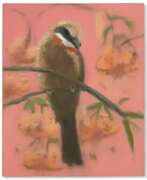

Ann Craven is a contemporary American painter known for her lush depictions of the moon, birds, and multi-colored stripes. Craven’s use of serial motifs belies her interest in ephemeral moments, seasonal cycles, and the changeable qualities of painting. She received her BFA from the Massachusetts College of Art in 1986 and her MFA from Columbia University in 1993. She notably served as an artist assistant to Alex Katz, whose work influenced her own. Much of Craven’s practice revolves around painting en plein air, in this way she has captured the moon on hundreds of nights over the years. The artist currently lives and works in New York. Today, her works are held in the collections of the Whitney Museum of American Art in New York, the Museum of Contemporary Art in Chicago, and the Institute of Contemporary Art in Miami, among others.
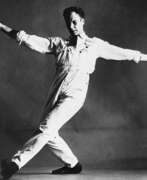

Mercier Philip "Merce" Cunningham was an American dancer and choreographer who was at the forefront of American modern dance for more than 50 years. He frequently collaborated with artists of other disciplines, including musicians, graphic artists and fashion designers. Works that he produced with these artists had a profound impact on avant-garde art beyond the world of dance. There have been numerous exhibitions dedicated to Cunningham's work. Also, his visual art is represented by Margarete Roeder Gallery.


Marcel Dzama is a contemporary artist from Winnipeg, Manitoba, Canada who currently lives and works in New York City. His work has been exhibited internationally, in particular his ink and watercolor drawings. Dzama works extensively in sculpture, painting, collage, and film. The artist is also known for his intricate dioramas and large scale polyptychs that draw from his talents across a range of media. Dzama works in multiple disciplines to bring his cast of human figures, animals, and imaginary hybrids to life, and has developed an international reputation and following for his art that depicts fanciful, anachronistic worlds.
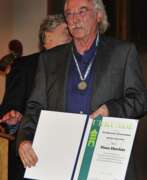

Klaus Eberlein was a German graphic artist, illustrator and ceramic sculptor. He initially completed training as a chromolithographer. From 1962 to 1968 he attended the Academy of Fine Arts in Munich, and from 1968 he was a master student of Hermann Kaspar, receiving a final diploma from the academy. Eberlein was a member of the Association for Original Etching, the Dachau Artists' Association and the Munich Artists' Association. In 2013 he was accepted into the South German literary association Münchner Turmschreiber.


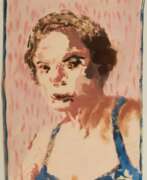

Simon English is a contemporary british artist. He is best known for his large and small-scale 'painted drawings' in which he mingles his distinctive imagery and words. He moves lightly between tight draftsmanship and a playfully sloppy application of colour and line. Language is paramount with diaristic musings interspersed with song lyrics, poetry and humorous one-liners. Self-described as 'automatic', his work has the spontaneity of stream-of-consciousness, exploring themes of love and loss, as well as gay and popular culture. Simon English lives and works in London. He emerged on the London Art scene in 1994 with an exhibition of paintings at the Saatchi Gallery as part of Young British Art III. Simon has exhibited internationally at numerous institutions.


Maria Paula Figueiroa Rego was a Portuguese-British visual artist known particularly for her paintings and prints based on storybooks. Rego's style evolved from abstract towards representational, and she favoured pastels over oils for much of her career. Her work often reflects feminism, coloured by folk-themes from her native Portugal.


Walton Ford is an American artist. He is known for his large-scale, highly detailed paintings that depict natural history subjects and explore the relationships between humans and animals.
Ford studied at the Rhode Island School of Design and later from Yale University. His work is inspired by the tradition of natural history painting, but he subverts this tradition by using his paintings to critique colonialism, environmental degradation, and the ways in which humans have interacted with the natural world.
Ford's paintings are highly detailed and often include multiple narratives within a single image. He uses a combination of watercolor, gouache, and ink to create his large-scale works, which can be several feet in height and width. His paintings are also highly stylized, featuring elements of graphic design and pop culture.
Ford has exhibited his work extensively, including at the Whitney Museum of American Art in New York, the Hamburger Bahnhof Museum in Berlin, and the Musée de la Chasse et de la Nature in Paris. His work is also held in the collections of several major museums, including the Museum of Modern Art in New York and the Smithsonian American Art Museum in Washington, D.C.
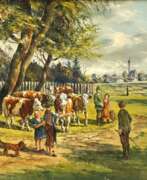

Alfred Fritzsching is a German artist known as Painter, graphic artist, draftsman, sculptor, commercial, commercial graphic artist. He began his training as a commercial graphic artist at the Blocherer School for Graphic and Advertising in Munich and worked as an advertising specialist. In 1970 Alfred Fritzsching became a member of Munich Artists 'cooperative and participated in exhibitions at the Haus der Kunst in Munich. From 1978, he worked as a freelance painter and also as board member and juror of the Munich Artists' Cooperative.


Piero Gilardi is an Italian painter and decorator. A catalytic figure in the Arte Povera movement centred in Turin in the late 1960s, Gilardi's utopian and selfless commitment to the association of neo-avant-garde artists from Western Europe and North America made him one of the most influential artistic figures of the period.
Piero Gilardi became internationally renowned and witnessed the influence of Pop Art in Europe. An itinerant artist, theorist and organiser, he contributed to the birth of Arte Povera, especially working to establish relationships with other similar initiatives that were simultaneously taking place outside of Italy.
Much of Gilardi's later work is united by a theme or interaction between the work and the viewer. The master has devoted more than a decade to his most ambitious project, Parco Arte Vivente (Park of Living Art or PAV). A collaborative effort that grew out of Gilardi's design, the PAV is a monumental undertaking that has transformed an abandoned plot of land in the heart of Turin's working-class Lingotto district into a six-acre green space dedicated to public, environmental and artistic interests.
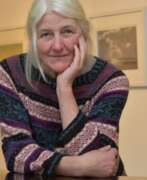

Frauke Gloyer is a contemporary German artist. She studied freehand painting at the University of Fine Arts in Braunschweig. She has been working as a freelance artist since 1988.
Frauke Gloyer's work includes expressionist landscapes, still lifes, portraits and animal studies.


Alexei Nikolaevich Glukharyov (Russian: Алексей Николаевич Глухарёв) is a Soviet and contemporary Russian artist. He is known as a painter and graphic artist, as well as a teacher.
Alexei Glukharyov worked as an art teacher and graphic designer in Central Asia at the beginning of his career. In 1984 his first solo exhibition in Moscow took place. From 1984 to 1990 he created a large collection of horse portraits for state stud farms and breeding farms. His works have been exhibited in Russia and abroad and are also in private and museum collections.


Vadim Alexeyevich Gorbatov (Russian: Вадим Алексеевич Горбатов) is a Soviet and contemporary Russian artist. He is known as a painter and graphic artist, animalist.
Vadim Gorbatov creates works that are based on field observations and realistic sketches. The artist studied the animal world in his travels from the Siberian tundra to the jungles of Cambodia. He has illustrated many books, including the Red Book of the USSR, and is involved in international projects such as the Artists for Nature Foundation, in which Gorbatov is the only Russian participant. He is also a member of the Union of Artists of Russia and the Wildlife Artists' Union of Great Britain.
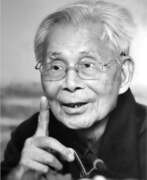





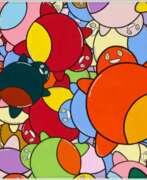

Eddie Kang is a contemporary korean artist. His brightly colored paintings depict doodles of toys and animals rendered in the Asian “Animamix” style, which melds the languages of animation and comics. Kang received his BFA from the Rhode Island School of Design. Early in his career, he caught the attention of curator Victoria Lu —who coined the term “Animamix” —and has since been included in a number of exhibitions she has organized. Among these are the inaugural Animamix Biennial at the Museum of Contemporary Art in Shanghai in 2007 and “Future Pass,” a collateral exhibition of the 2011 Venice Biennale. Kang’s playful paintings feature a cast of teddy bears, puppies, and dolls meant to serve as companions to city dwellers who feel isolated in an increasingly digital world. In addition to creating artworks, Kang has collaborated with fashion brands such as MCM and Paul Smith to create wearable goods that further circulate his characters.


Helen Khal was an American artist and critic of Lebanese descent. She started her painting career at the age of 21. She held her first individual exhibition in 1960 in Galerie Alecco Saab in Beirut. Her other one-woman shows took place at Galerie Trois Feuilles d'Or, Beirut (1965); Galerie Manoug, Beirut (1968); at the First National Bank, Allentown, Pennsylvania (1969); in Kaslik, Lebanon (1970); at the Contact Art Gallery, Beirut (1972, 1974 and 1975) and at the Bolivar Gallery in Kingston, Jamaica in 1975. Her work also appeared in the Biennales of Alexandria and São Paulo. She also taught art at the American University of Beirut from 1967 to 1976 and at the Lebanese American University from 1997 to 1980. She inspired many other artists. Helen Khal was also recognized as an author and critic. "From 1966 to 1974, Helen Khal was Art Critic to two Lebanese periodicals, The Daily Star and Monday Morning.


Dongi Lee is widely known Korean pop artist who works with popular cartoon-like images. He has attempted to show the result of cultural mixtures that combines two disparate codes such as pop characters like AtoMouse and abstract painting, which reflects our current society in which communication and harmony became a difficult task.


Li Tianbing is a Chinese artist. Li Tianbing’s body of work is characterized by the dual influence of the Far-East and the West: the first being a legacy of Chinese painting imbued with Taoism, the second coming from the teachings of art professors such as Vladimir Veličković, Christian Boltanski and Giuseppe Penone while he studied at the Fine Arts School in Paris. His work was marked by a pivotal moment in 2006, when he compiled a family album comprising portraits of him as a child, for the purpose of denouncing the one-child policy, thus depicting an imaginary family through replications of himself. He henceforth developed a new visual language in which portraits abound, creating through his art a dialog between reality, imagination and fantasy. When working on his compositions, Li Tianbing essentially uses oil paint; however, another of his main means of expression remains drawing with Indian ink. He also enjoys working with watercolours, alternating between Chinese and European paintbrushes.


Judith Linhares is an American painter, known for her vibrant, expressive figurative and narrative paintings. She synthesizes influences including Expressionism, Bay Area Figuration, Mexican modern art and second-wave feminism, in work that flirts with abstraction and balances visionary personal imagery, expressive intensity, and pictorial rigor. In the early 1970s, Linhares created narrative drawings and assemblages that appropriated commonplace or "craft" materials and feminine imagery (flowers, eggs, swan feathers, domestic scenes). After 1980 she developed a Symbolist allegorical world of enigmatic, bulbous-headed creatures, narcoleptic nudes, phantasms, figures in boats, and human metamorphosis. Her fantastic imagery was balanced by lush color, painterly sensual surfaces, and sure design. Through the 1990s, critics noted in her work a sunnier palette, increasingly abstract and ambiguous imagery, and a growing facility with a naïve drawing style. In the 2000s, Linhares has turned to female nudes (often monumental), visionary landscapes, floral still lifes and animals. Linhares has been recognized with more than forty-five one-person exhibitions and major awards from the American Academy of Arts and Letters and John Simon Guggenheim Memorial Foundation.




Gilbert Lujan was an American sculptor and muralist. He is better known in professional circles under the pseudonym "Magu".
Magu's work became popular throughout the 1980s and 1990s for its use of colourful imagery, anthropomorphic animals, lowrider images of outrageously proportioned sizes, decorated with overlapping indigenous motifs (cities, graffiti), Dia De Los Muertos installations, altars and all manner of pop culture borrowings.


Andrew Mansfield is a British Painter, born in Leicester, who studied at Loughborough College of Art and Design, 1970-3, and Portsmouth Polytechnic, 1976-9. In 1987 he was an artist-in-residence in Lisbon. His solo shows included Spacex Gallery, Exeter, 1984; Winchester Gallery in Winchester, 1985; Midland Group, Nottingham, the same year; and Anthony Reynolds, 1986.




Yevgeny Pavlovich Melnikov (Russian: Евгений Павлович Мельников) was a Soviet artist of the second half of the twentieth and early twenty-first centuries. He is known as a painter, teacher and poet who had a great influence on the development of the national school of modern painting in Uzbekistan.
Yevgeny Melnikov excelled in portrait painting, still life, landscape and animalistic compositions. His works were characterized by painterly temperament, energy of stroke and non-standard compositional solutions. In his works one can find both traditional elements of still life (fruits, flowers) and unusual objects (organ pipes, fish). The master also introduced into his compositions fragments from the works of his favorite French post-impressionists.
Melnikov's works are in museums and private collections in Russia, France, Germany, Holland, Sweden and many other countries.
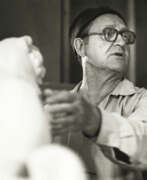

Evgeny Vasilievich Nikolaev (Russian: Евгений Васильевич Николаев) was a Soviet and Russian artist of the second half of the twentieth and early twenty-first centuries. He is known as a sculptor, stonecutter, animalist and teacher.
Evgeny Nikolaev was a regular participant of animalistic exhibitions both in the Soviet Union and abroad, which contributed to his creative development. He was also a pedagogue, teaching drawing and composition at the Moscow Institute of Technology. His multifaceted skill was expressed in working with different materials, from stone and porcelain to metal. Nikolaev's sculptures are in the collections of various museums.


Vitaly Nikolayevich Onkov (Russian: Виталий Николаевич Оньков) was a Soviet and Permian Komi artist of the last third of the twentieth and early twenty-first centuries. He is known as a graphic artist and sculptor.
Vitaly Onkov created works reflecting the nature and fauna of the region, as well as elements of Permian Komi pagan and pseudo-Christian mythology. The artist created many paintings and graphic works, including drawings with Permian Komi folk types. He was also one of the authors of the coat of arms and flag of the Permian Komi Autonomous District of the Russian Federation.


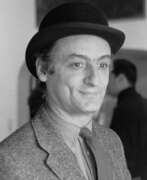

Larry Rivers (born Yitzroch Loiza Grossberg) was an American artist, musician, filmmaker, and occasional actor. Considered by many scholars to be the "Godfather" and "Grandfather" of Pop art, he was one of the first artists to merge non-objective, non-narrative art with narrative and objective abstraction.


Alexis Rockman is an American contemporary artist known for his paintings that provide depictions of future landscapes as they might exist with impacts of climate change and evolution influenced by genetic engineering. He has exhibited his work in the United States since 1985, including a 2004 exhibition at the Brooklyn Museum, and internationally since 1989.
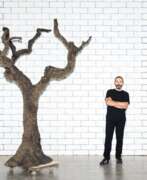

Ugo Rondinone is a Swiss-born artist widely recognized for his mastery of several different media — most prominently sculpture, drawing and painting, but also photography, architecture, video and sound installation — in the largely figurative works he has made for exhibitions in galleries, museums and outdoor public spaces around the world. He has never limited himself to a particular material, no more than he has to a single discipline. Lead, wood, wax, bronze, stained glass, ink, paint, soil and stone are all tools in a creative arsenal that the artist has employed to extend the Romantic tradition in works that are as sensitive to the passage of time as to the nuances of body language and the spoken word.


Sebastião Ribeiro Salgado is a Brazilian social documentary photographer and photojournalist.
He has traveled in over 120 countries for his photographic projects. Most of these have appeared in numerous press publications and books. Touring exhibitions of his work have been presented throughout the world.
Salgado is a UNICEF Goodwill Ambassador. He was awarded the W. Eugene Smith Memorial Fund Grant in 1982, Foreign Honorary Membership of the American Academy of Arts and Sciences in 1992 and the Royal Photographic Society's Centenary Medal and Honorary Fellowship (HonFRPS) in 1993. He has been a member of the Académie des Beaux-Arts at the Institut de France since April 2016.




Anett Stuth is a German photographer. With her photographs, Anett Stuth invents multiple architectures in which interior and exterior, high and popular culture, photography and painting overlap. From basic documentary motifs, Stuth layers and collages imaginary interiors, urban or natural landscapes. At the same time, they make the possibility space of the virtual age perceptible. With the technique she has been developing since 2003, Stuth transcends the usual dimension of photographic space and redefines it.


Kaya Theiss is a contemporary american artist. Her first verified exhibition was Möpse at Galerie Thomas Hühsam in Offenbach in 1998, and the most recent exhibition was Walhalla at Galerie Thomas Hühsam in Offenbach in 2016. Kaya Theiss is most frequently exhibited in Germany, but also had exhibitions in Spain, United States and elsewhere.


Rob Thom is a contemporary american artist. He received his MFA from the University of California, Los Angeles in 2004. His work has been featured in international exhibitions. His work is held in numerous private and public collections. Rob Thom’s densely allegorical paintings are keen, satirical observations of contemporary life. The artist brings a particular carnival of American grotesque onto the canvas with wry humor, painstaking observation and deft skill. Touching upon the traditions of painting and art history, including James Ensor’s crowds and Pieter Brueghel’s busy tableaux of peasants, Rob Thom’s compositions vividly capture everyday life and all the banal and absurd vagaries of the human condition.
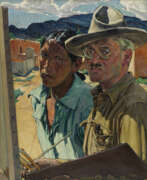

Walter Ufer is an American illustrator and muralist. He received his formal art education in Hamburg and Dresden, where he befriended the American artists Joseph Henry Sharpe and Ernest Blumenschein. In 1906, Ufer moved to Taos, New Mexico, where he became part of a group of painters known as the Taos Society of Artists.
Walter Ufer was drawn to the rugged landscape of the American West and the culture and daily life of the Pueblo Native Americans. Ufer's paintings are characterized by vivid colours and a free-spirited style of painting, conveying the energy and movement of his subjects. He often paints scenes of hunting, horseback riding and other outdoor activities.
Ufer's work was widely acclaimed during his lifetime and he received many awards for his paintings.
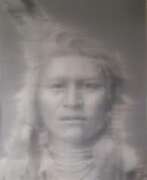



Ingeborg von Einsiedel, a German graphic artist, studied at the State Academy for Graphic Arts and Book Trade in Leipzig. She worked closely with Karl Max Schneider, the director of the Leipzig Zoo, and was responsible for the signage of the enclosures and the animal books. After Schneider's death, she took care of his scientific legacy and became the "soul" of the zoo. She also created wood engravings depicting animals and plants.


T. J. Wilcox is a contemporary American artist. Wilcox’s work is characterized by a fascination with personal narrative and the ways in which history is always under construction, woven from fact, myth, memory, associations, and the bombardment of information we all receive on a moment-to-moment basis. T. J. Wilcox is mainly known for his super 8 films transferred to video, 16 mm film projections, collages and installations of famous people and their glamorous – sometimes harrowing and dramatic – stories. Fact meets fiction (at times the artist’s own fantasy or history) in beautifully haunting portraits of the famous Marie Antoinette, Marlene Dietrich, Czar Nicholas of Russia, or the Marchesa Luisa Casati. These portraits continue in his work with the not so famous, such as his close friends, the superintendent of his studio building and his beloved French Bulldog. The collaged films are often romantic and decadent in their subjects and subject matter, and their stunningly beautiful vignettes often blur biography and autobiography and embrace the romantic history and escapism of cinema.
